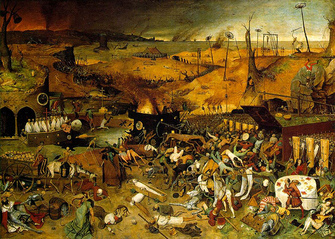« Prev Next »
Things seem to be looking up for rats. After more than 500 years, rats may be off the hook for causing the Black Death, the horrible plague that claimed up to 60% of the European population. In virtually every textbook the Bubonic Plague, which is spread by flea-ridden rats, is named as the culprit behind the chaos. But mounting evidence suggests that an Ebola-like virus was the actual cause of the Black Death and the sporadic outbreaks that occurred in the following 300 years.
At the forefront of this theory are two researchers from the University of Liverpool, Dr. Christopher Duncan and Dr. Susan Scott. Let's look at six small pieces of this puzzle.
1. Where are the rat bodies?
Bubonic Plague is caused by the bacteria Yersinia pestis. Many rodents, such as rats, carry the infected fleas and in turn become sick.

2. Over the Speed Limit
Dr. Duncan and Dr. Scott argue that the breakneck rate that the Black Death tore across Europe could not be sustained by a flea-borne plague. The Black Death spread about 30 miles every two to three days, according to Duncan. However, Bubonic Plague moves much slower at a rate of only 100 yards a year. The math just doesn't fit; the Black death spread on average 10 miles per day while the Plague moves under one foot per day. A person-to-person transmissible virus such as Ebola would have been able to spread at the rate observed.
3. It's in the Incubation Period
The Black Death not only spread rapidly but also over a large area. Originally thought to have begun in Asia, the sickening agent was carried by Genoese sailors to Italy. From there it traveled across continental Europe and into England. Funny thing is, the incubation period (the time it takes from the initial infection to the onset of symptoms) for the Plague is very short - about two to six days. Since transportation was less efficient in the 14th century it took a longer time to travel great distances. Therefore, if the Plague was making people terribly sick in only two to six days it should have not spread as far as it did. A person with the Plague could not have traveled very far before coming down with the debilitating symptoms. People would have died off too quickly with the Plague for the sickness to spread over great distances. On the other hand, Ebola's incubation period ranges from 2 -21 days. This means that a person harboring an Ebola-like virus most likely could have traveled a longer time than one with the Plague and spread the sickness over a greater distance before succumbing to the virus.
4. Similar Symptoms
Reports from the time of the outbreak detail symptoms in plague patients that are comparable to the ones caused by viral
5. Forty-Day Quarantines
Ebola's course of infection lasts around 37 days according to Dr. Duncan and Dr. Scott. This includes a 10 day incubation period followed by a 22 day infectious period whereby the person could be infectious but not exhibit symptoms. In the last five days the most gruesome symptoms appear in people. The 37-day estimate fits nicely with the 40-day quarantines carried out in Europe during the Black Death. Quarantine efforts in Europe were successful according to the two doctors. Sanctioning off infected families effectively "stopped the spread [of disease]." The 40-day period would have allowed for Ebola to run its course, eliminating the possibility of seemingly healthy people from infecting others during the initial 32-day period. Rats, on the other hand, would have ignored the quarantines. Thus, quarantines of plague victims could not have been as successful as an Ebola quarantine since rats are independent creatures; rats would have still been able to infect people despite a quarantine.
6. The Rats Die Too
In England and Northern Europe there are no native rat populations that can contract the Plague and live. By that logic, the Black Death should have caused a mass die-off of rats in those regions. For 300 years after the Black Death other smaller outbreaks occurred throughout Europe. Here's the twist: if the majority of native rats died in England and Northern Europe then the Bubonic Plague would have had a hard time "establishing" itself in between outbreaks. An outbreak would have required a large rat population. Dr. Duncan argues that a viral-hemorrhagic fever could have laid low in the human population between outbreaks, reemerging when the conditions were right.
Of course, there are always two sides to every argument. The majority of scientists and historians still agree with the theory that the

The Ebola-like virus theory has important implications for the modern world. With modern hygiene and antibiotics another epidemic of Bubonic Plague is highly unlikely. Foundations have been set up to prevent another Bubonic Plague epidemic. Rat populations can be monitored to snuff the destructive flea-rat-human cycle in the bud. The small outbreaks that sporadically occur around the world are dealt with before they grow too large. Since the Black Death, humanity has gained the ability to control the Plague. But a hemorrhagic-virus epidemic would be a whole other story. Humankind would be unprepared if an epidemic like the Black Death caused by a hemorrhagic fever took place today. Unlike the Plague, limited treatment and prevention options are available for hemorrhagic fevers. There are no vaccines and no antibiotics. Hemorrhagic fever outbreaks take place rather spontaneously with little or no forewarning. If the Ebola-like virus theory is right, then the world may be susceptible to another major epidemic.
References:
Cohen, J. "Can we stop blaming rats for the Black Death?" History. August 18, 2011.
Derr, M. "New theories link Black Death to Ebola-like virus." The New York Times. October 2, 2001.
Sterling, J. "Was Ebola behind the Black Death?" ABC News. July 30, 2013.
Images:
The Triumph of Death: summoning_ifrit (via Flickr)
Yersinia pestis: NIAID (via Flickr)























